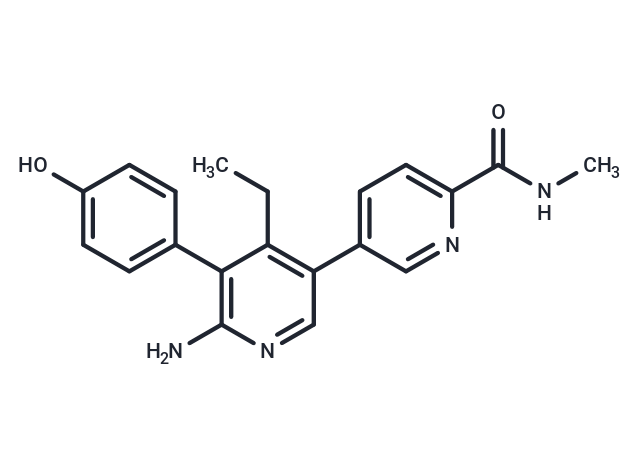Shopping Cart
Remove All Your shopping cart is currently empty
Your shopping cart is currently empty
GNE-6776 is a selective USP7 inhibitor.

| Pack Size | Price | USA Warehouse | Global Warehouse | Quantity |
|---|---|---|---|---|
| 1 mg | $74 | In Stock | In Stock | |
| 5 mg | $178 | In Stock | In Stock | |
| 10 mg | $287 | In Stock | In Stock | |
| 25 mg | $552 | In Stock | In Stock | |
| 50 mg | $793 | In Stock | In Stock | |
| 100 mg | $1,080 | - | In Stock | |
| 1 mL x 10 mM (in DMSO) | $197 | In Stock | In Stock |
| Description | GNE-6776 is a selective USP7 inhibitor. |
| In vitro | GNE-6776 non-covalently targets USP7 12?? distant from the catalytic cysteine. GNE-6776 attenuates ubiquitin binding and thus inhibits USP7 deubiquitinase activity. GNE-6776 interacts with acidic residues that mediate hydrogen-bond interactions with the ubiquitin Lys48 side chain. GNE-6776 targets cellular USP7, MDM2, and p53 signalling pathways.GNE-6776 selectively inhibits recombinant USP7 relative to 36 other deubiquitinases. GNE-6776 remains selective even at 100?μM, a more than sixfold higher concentration than used in cellular assays. GNE-6776 significantly inhibits USP7 while remaining selective against 44-47 other detected deubiquitinases. |
| In vivo | Although efficacious exposure is only transiently achieved, GNE-6776 causes modest, although significant, EOL-1 xenograft growth delay. |
| Synonyms | GEN6776 |
| Molecular Weight | 348.4 |
| Formula | C20H20N4O2 |
| Cas No. | 2009273-71-4 |
| Smiles | CCc1c(cnc(N)c1-c1ccc(O)cc1)-c1ccc(nc1)C(=O)NC |
| Relative Density. | 1.242 g/cm3 (Predicted) |
| Storage | store at low temperature | Powder: -20°C for 3 years | In solvent: -80°C for 1 year | Shipping with blue ice/Shipping at ambient temperature. | |||||||||||||||||||||||||||||||||||
| Solubility Information | DMSO: 310 mg/mL (889.78 mM), Sonication is recommended. | |||||||||||||||||||||||||||||||||||
| In Vivo Formulation | 10% DMSO+40% PEG300+5% Tween 80+45% Saline: 5 mg/mL (14.35 mM), Sonication is recommended. Please add the solvents sequentially, clarifying the solution as much as possible before adding the next one. Dissolve by heating and/or sonication if necessary. Working solution is recommended to be prepared and used immediately. The formulation provided above is for reference purposes only. In vivo formulations may vary and should be modified based on specific experimental conditions. | |||||||||||||||||||||||||||||||||||
Solution Preparation Table | ||||||||||||||||||||||||||||||||||||
DMSO
| ||||||||||||||||||||||||||||||||||||
| Size | Quantity | Unit Price | Amount | Operation |
|---|

Copyright © 2015-2025 TargetMol Chemicals Inc. All Rights Reserved.